[IBM PC, Avalon Hill]
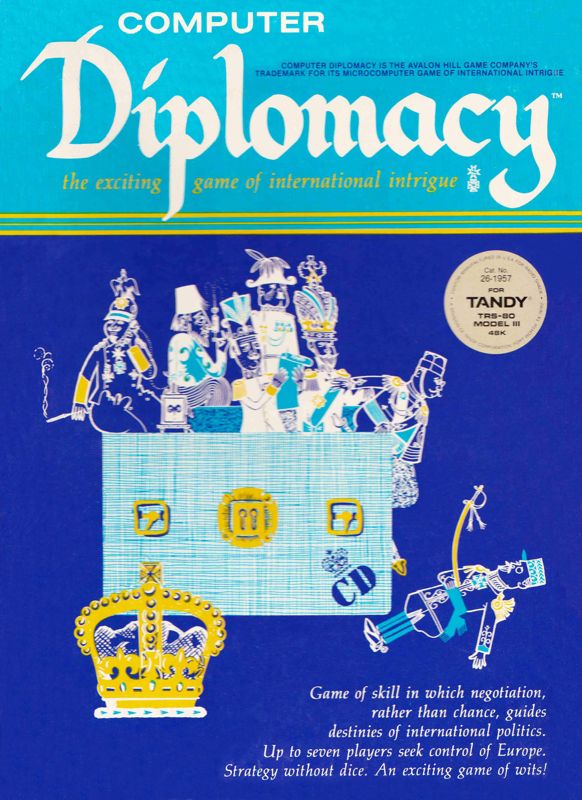
I usually don’t play computer board games, but Diplomacy is special. In 1959, Allan B. Calhamer released the second most famous wargame in history: Diplomacy. While not a household name like Risk, Diplomacy is probably the most analyzed board game after Chess and, possibly, Go. I surmise that most of my readers know the rules, as Diplomacy should be on the bucket list of any gamer. For the others, the game puts 7 players in charge of the Great European Powers of 1901: France, United Kingdom, Germany, Austria-Hungary, Italy, Russia and Turkey. The game ends when one of the players manages to control 18 “supply centres”, when the game has a stable stalemate, after a pre-agreed number of turns (often 14) or, more commonly, when it is late at night and the bowl of chips is empty.
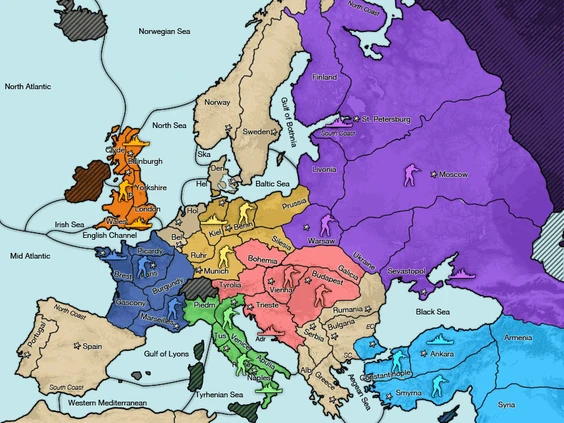
The map has not changed since 1959, except for a few names.
What makes Diplomacy closer to an abstract board game like Chess than a wargame is the absence of randomness. There is no dice in Diplomacy, a force attacking another of the same size will always fail, while any numerical advantage will always succeed. As the 7 countries start equally powerful (3 armies/fleets each, except Russia with 4) and each region can only host one army/fleet, the only way to win is to build coalitions, ententes, non-aggression pacts, alliances, whatever is needed to gain numerical advantage where it matters. In a typical Diplomacy game, everyone makes promises during the “negotiation” phase of the game (“I let you take Greece with your Austrian fleet in Albania if your army in Budapest supports my attack from Bulgaria against Russian Romania“), then they write their order. During the “resolution” phase, all players discover who is a true friend and who is a conniving snake when the orders are read aloud and solved simultaneously (“While you were supporting my non-existing attack from Bulgaria to Romania, I was supporting the Russian attack from Romania to Serbia”). It is great fun. It is also particularly intense, and I have lost one real-life friend to it but come on, Thomas should not have flipped that board just because I backstabbed him.
In his 1980 Complete Book of Wargames, Jon Freeman rates the game “Excellent” and describes it thus:
“This is probably the most famous wargame in existence and certainly the one most played by the “outside world”. The double-dealing required attracts some people irresistibly and repels others just as strongly. […] The simple mechanics are militarily unrealistic (to put it mildly), but all attempts to “improve” the game […] have inevitably taken something away from the subtle machinations that make the game what it is. […] The game does, however, suffer from two major difficulties: the number of players required and the time it takes to play.
Avalon Hill had taken control of the Diplomacy license in 1976, and in 1984 ported the game to TRS-80 and IBM PC. However, the uncreatively named Computer Diplomacy was designed to be played in multiplayer, and by players already familiar with the boardgame. This is most evident when reading the back of the box and its two paragraphs explaining how the port addresses one of the “difficulties” mentioned by Jon Freeman:”the [board] game had one flaw: by far the best version of the game requires seven players […] but now 6 or fewer players can compete and the computer resolves the moves of the other nations.”
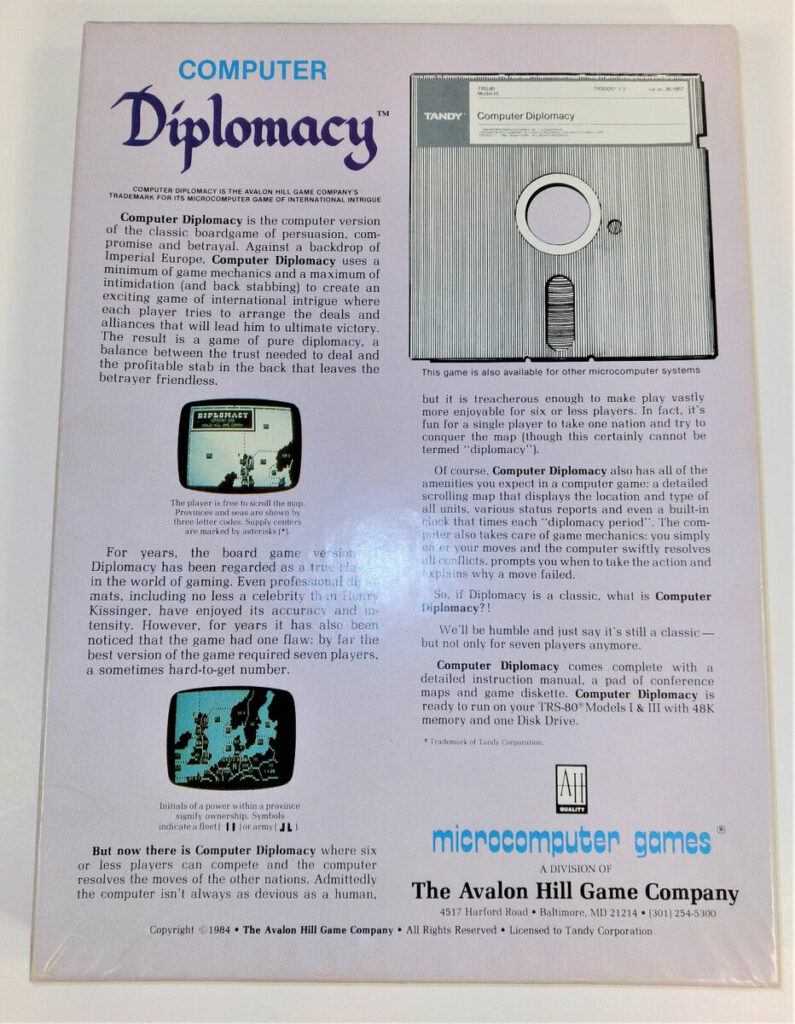
This may explain the obvious, glaring, shocking flaw when playing this 1984 port: the computer in Computer Diplomacy does not do diplomacy, at least not with the player. Still, the “no-negotiation Diplomacy“ is one of the most popular variants of Diplomacy (under the name “gunboat Diplomacy“), and I have never played it. I guess it is an opportunity. I will do that with the country with the worst win rate in Diplomacy: Italy.
Italy starts in a peculiar situation in Diplomacy. One reason is obvious: one of its supply centres, Venice, is immediately adjacent to one of Austria’s (Trieste). Other reasons are harder to grasp when discovering the game but well-known in Diplomacy-theory: in a nutshell Italy is the only country that can choose its starting alliance as neither France nor Austria will want a two-front war… but also one of the easiest countries to bottleneck if those two countries don’t trust it.
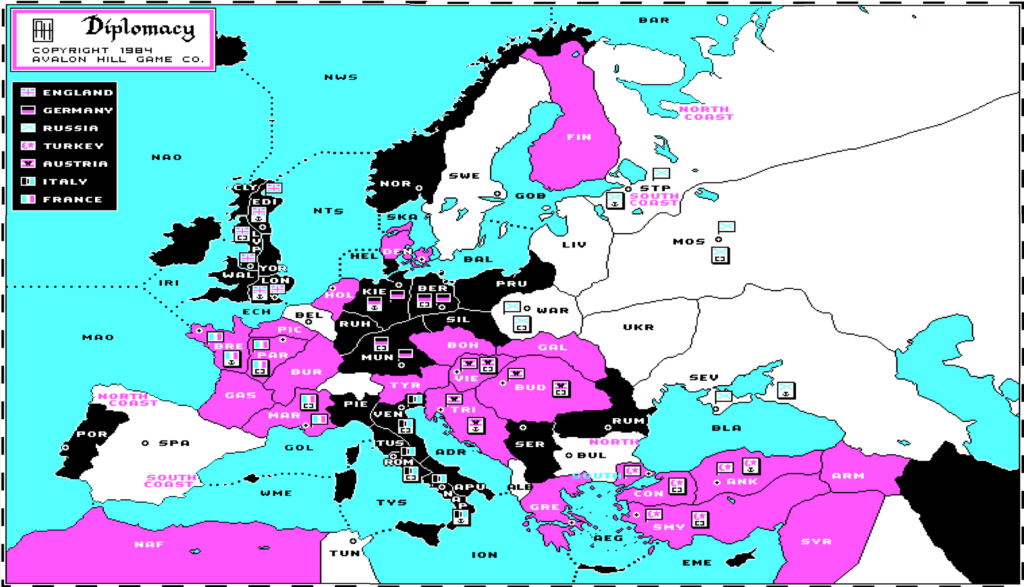
Computer Diplomacy religiously follows the rules of tabletop Diplomacy and the computer is a weak opponent, so I am going to do what Italian Diplomacy players always dream of doing but never dare to because it is an utterly terrible move: a direct attack on both France and Austria year one!

In Diplomacy, players have as many armies/fleets as they have supply centres, and these change ownership if another power occupies them every other turn, at the end of the year (“Autumn”, with “Spring” being the first part of the year). My strategy is therefore to move my armies North to the borders in Spring (something that would have ringed immediate alarm bells against real players), and then casually cross the border and occupy MARseilles and TRIeste in Autumn. With the conquest of the neutral & undefended Tunisia by my fleet, I will have 6 centres, and 6 armies or fleets, at the start of 1902.
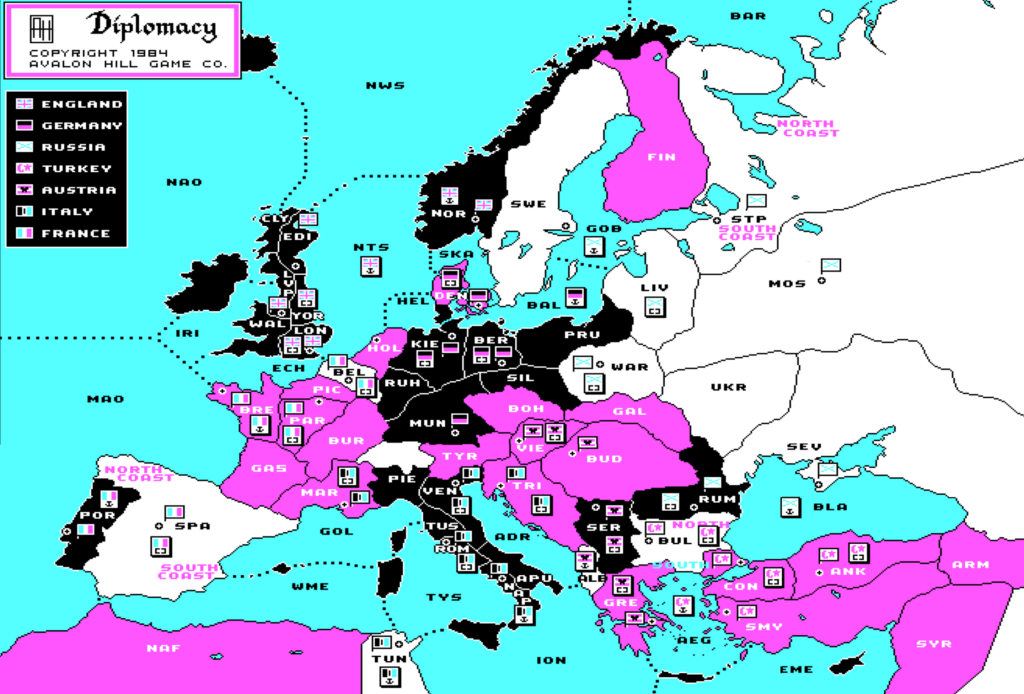
After this explosive start, it is a two-front war against the Austrians and the French. In a real game, everyone would have smelled weakness, particularly for Austria which has lost TRIeste, and joined the dog pile. Alas, the AI in Computer Diplomacy is extremely risk-adverse, so the Turks go all defensive just in case the Austrians attack them (“The army in BULgaria supports CONstantinople defensively, the fleet in the AEGean Sea supports BULgaria defensively, …) allowing the Austrians to block my expansion East. Meanwhile the British are laser-focused on doing nothing useful and I poorly anticipate the defensive strategy of the French, so I don’t expand West either. A lost year.
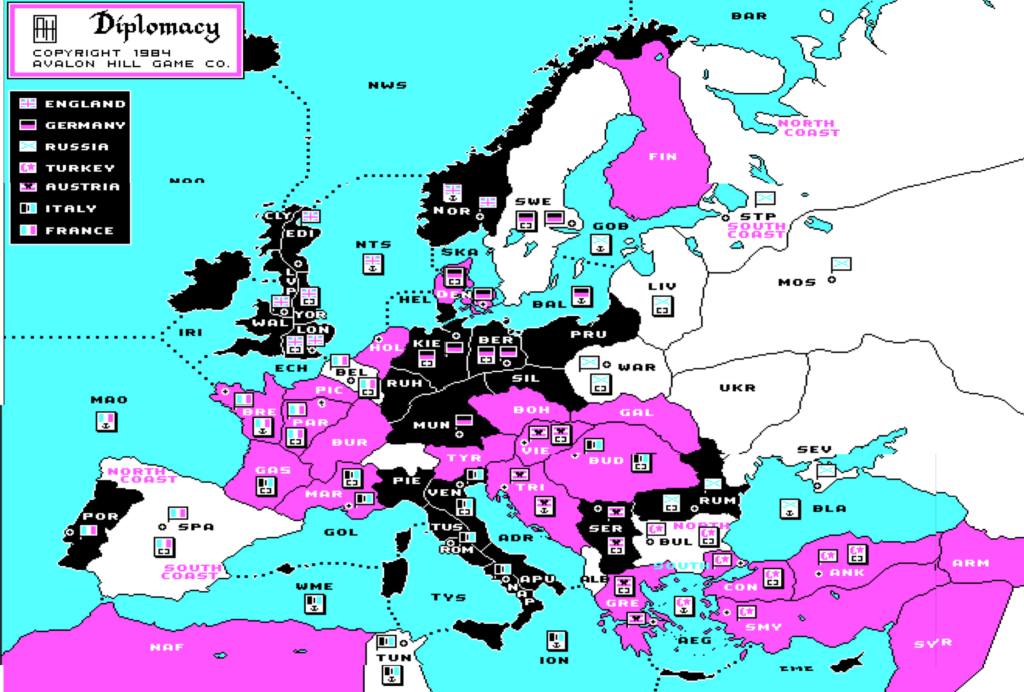
However, I perfectly anticipate the defensive strategy of the Austrians in the following turn and occupy all their core territory. I am also lucky in France (one of my armies is dislodged from GAScogne, but can retreat to PARis). My neighbours are broken. I would be perfectly happy with this development if the Turks had not snuck a fleet in the Ionian Sea and the Austrians retreated to Venice…
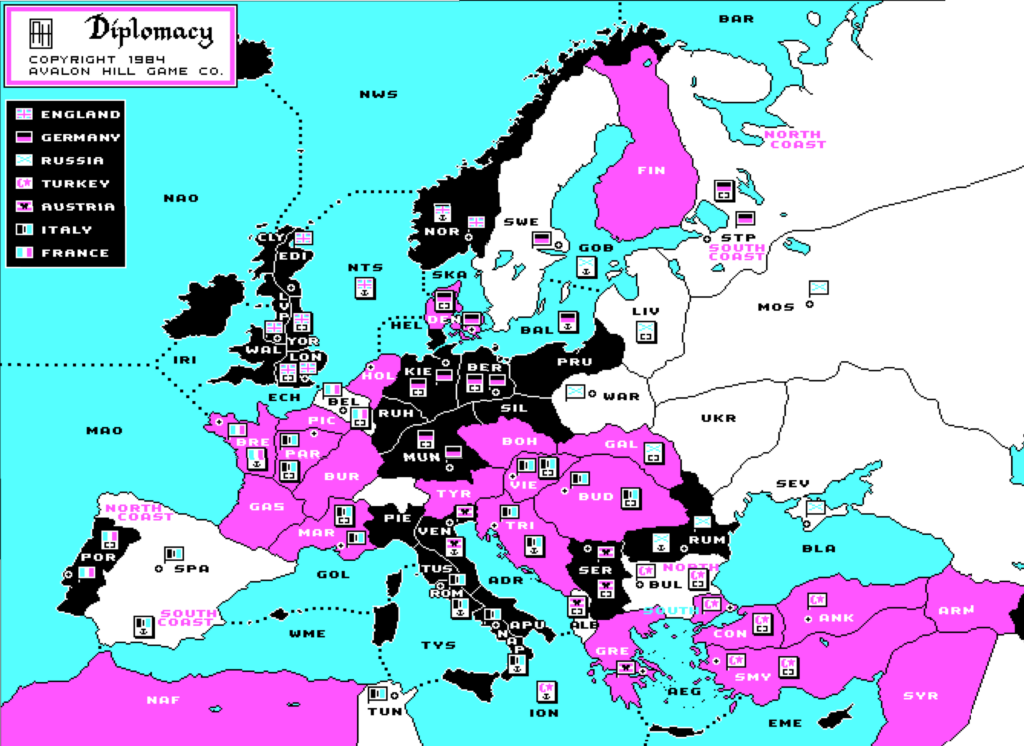
Those two hostile units in the middle of my Empire really cramp my style in the following turns, as I need to allocate three fleets or armies to prevent them from doing damage. A couple of sub-optimal choices make me lose TRIeste again, but at least in the West I manage to reach the Atlantic (MAO) from which I can take BREst.
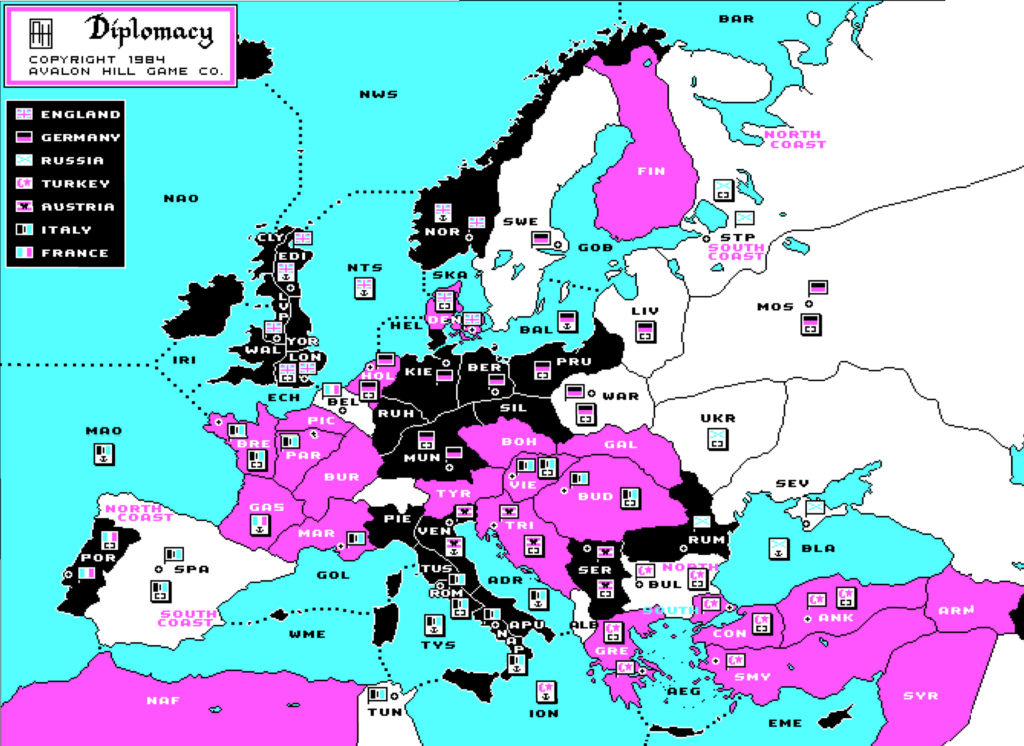
The French are reduced to two centres, and as such two fleets or armies. Frustratingly, they decided to keep their fleet in GAScony, instead of BELgium where one of their two centres is. The fleet can’t move to MARseilles (no sea connection) but it can threaten both SPAin and BREst, so it keeps two of my assets mobilized, on top of those allocated to counter the Turkish fleet in IONian. I don’t have a lot of units left for my offensive, it takes me time to position my forces properly for the endgame.
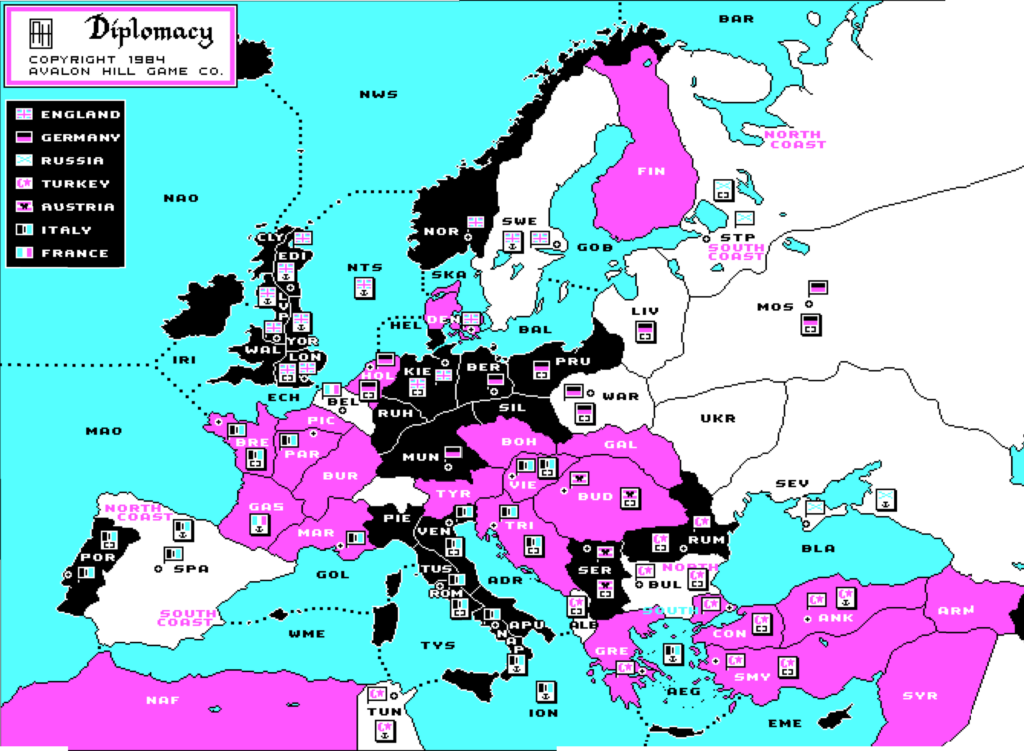
The British help me indirectly by taking the last French holdout, just as I remove the last Austrians from Austria:
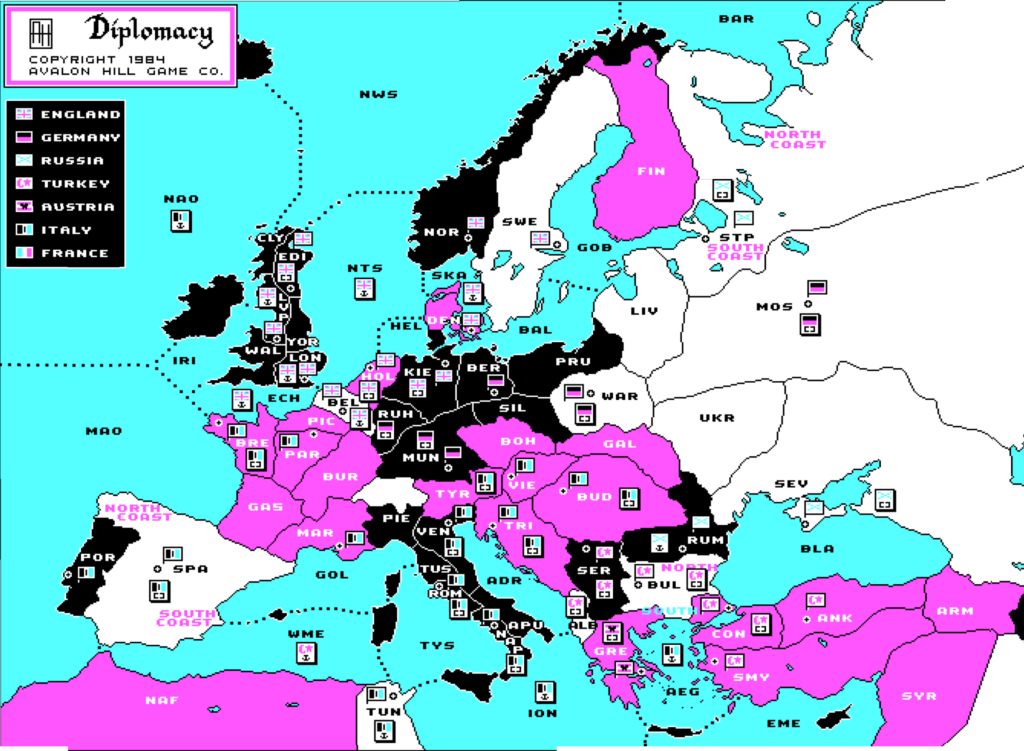
France is gone – thanks Edward – so there is no more GAScon army to keep at bay:
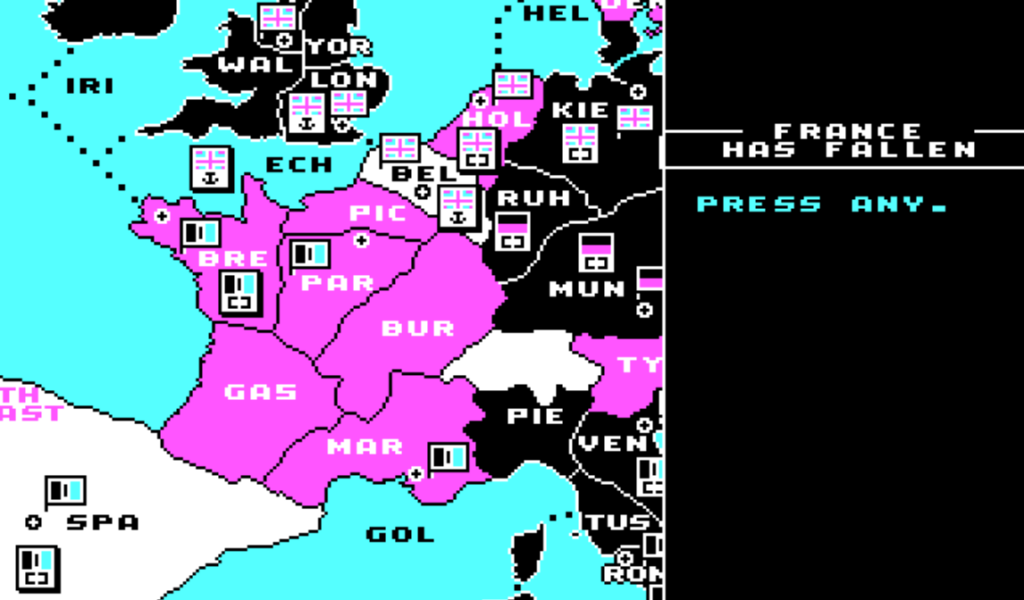
The game is won at 18 supply centres, and I have only 12. I want to win before the end of 1907, so I go all out, with for instance a naval landing from NAPles to SMYrme and a sneak attack on Liverpool (LVP), but that’s not enough for an immediate victory:
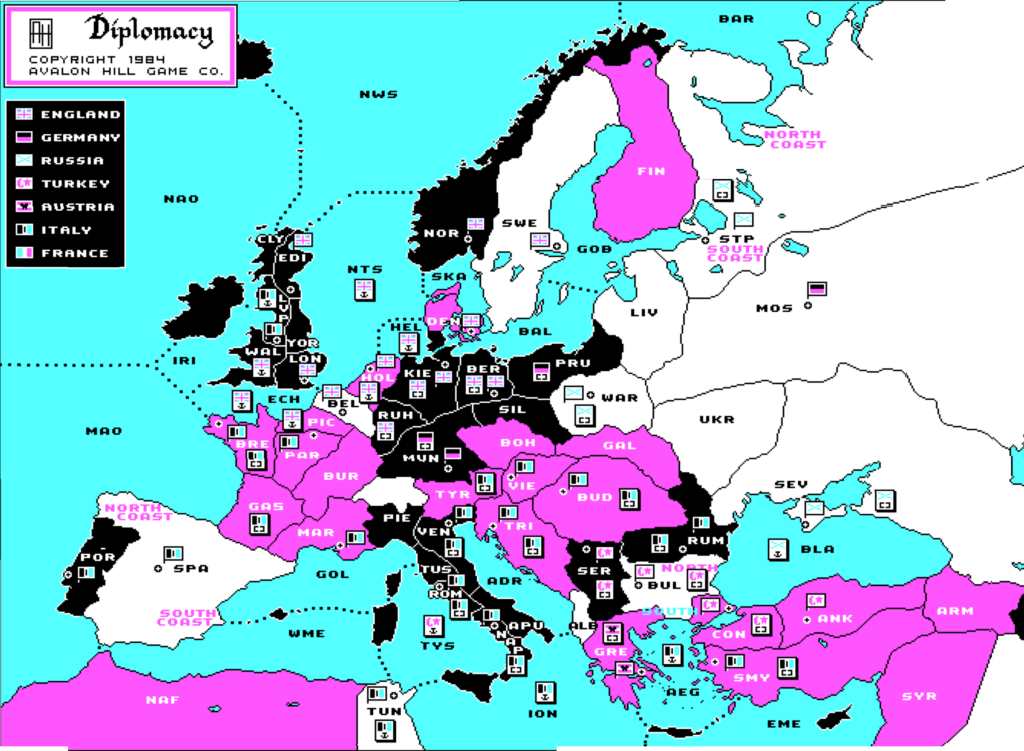
I expect the game to end there, but it continues, and I realize that the 14 turns limit is just the home rule I got used to in my circle of friends – the vanilla ruleset has no turn limit.
I don’t take a lot more time: I had overwhelming forces in the Balkans and I am able to “break” all the possible defensive support – I swallow everything from Serbia to Constantinople in 2 turns, winning the game during the Fall 1908-Spring 1909 adjustment:
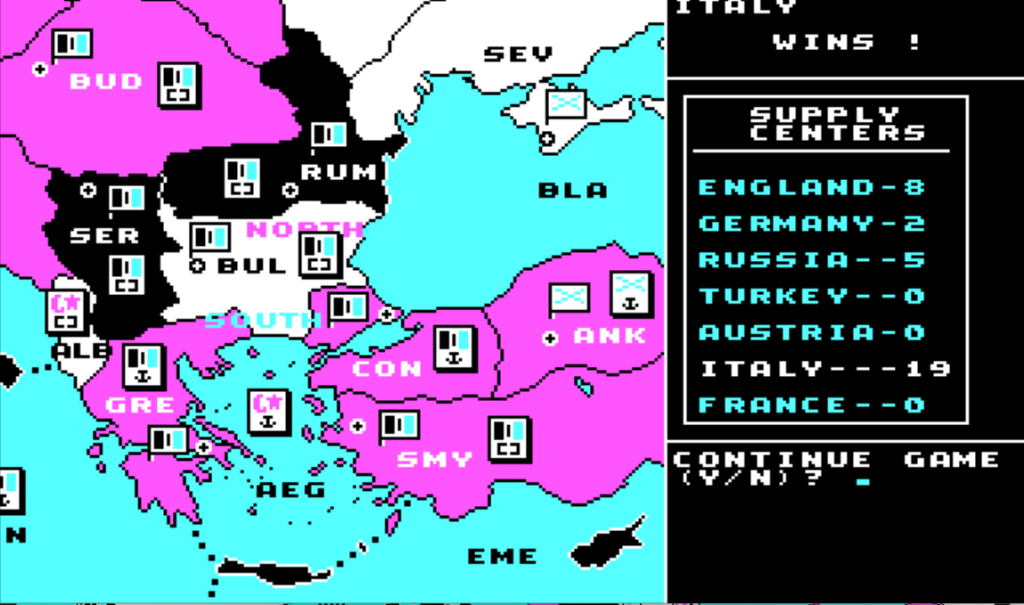
It is my first victory at Diplomacy ever: I have an uncanny skill for being exactly second, never first, rarely third or worse, and eliminated only once ever. I am not too proud of course, it was against a bunch of computer players.
Ratings & Reviews
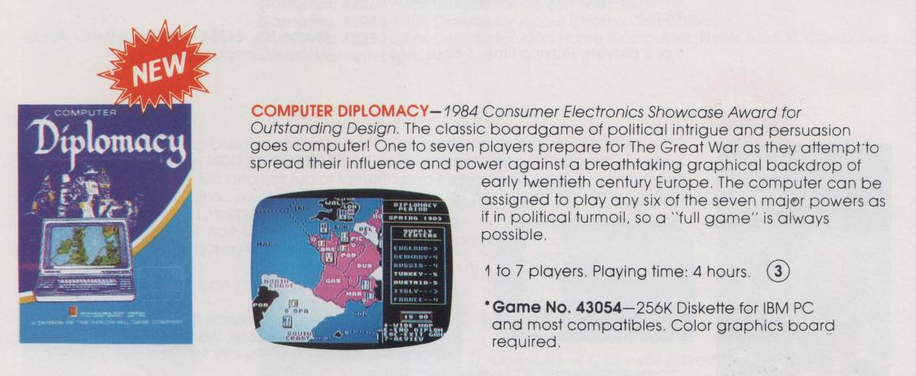
Computer Diplomacy by Ron Sutherland, published by Avalon HIll, US
First release : April 1984 on TRS-80 and IBM PC
Average duration of a campaign : 1 hour
Total time played : 3 hours
Complexity: Average (2/5)
Final Rating: Two stars, because it’s Diplomacy
Ranking at the time of review: 23/128, also because it’s Diplomacy
Computer Diplomacy is the exact port of Diplomacy and has been designed at least as much as an assistant to the board game than as a self-sufficient game. This is evident both from the marketing materials and the in-game features, which include several tools to turn the computer into an adjudicator. This includes:
- An option to let the computer allocate the players to the different countries,
- Strict timekeeping, with an option to change the time allocated to the “negotiation phase” (which is of course pointless in solitaire, given there is no negotiation in the game),
- Detailed combat resolution explanation,
- An option to alter the setup (location of armies, owners of supply centres and year).
In this context, the defensive nature of the AI strategy and its lack of diplomacy makes perfect sense. To understand this, one needs to know the highly disliked official Diplomacy rules for games with fewer than 7 players: putting some countries in “Civil Disorder”. Countries in Civil Disorder start with all their armies on the board, but they don’t move, don’t support one another and disband if forced to retreat. These rules deeply upset the balance of the game: for instance at 6 players the country under Civil Disorder is Italy, removing a front to an already powerful France and giving it free supply centers to capture. Players using Computer Diplomacy to fill the 7th seat are not looking for a super-brain stealing the show, and probably don’t want real players taking turns sending diplomatic proposals to the computer either, they just want an automaton defending its territory properly and keeping the map balance as designed.
I am not sure on which platform Computer Diplomacy was first coded, but until 1990 the game was only available on IBM-PC and on TRS-80. The IBM-PC required 256KB of memory when the IBM PC has only 64KB out of the box; the game could still be played without enough memory but the map could not be scrolled down so it was effectively played blind. As for the TRS-80 version, Radio Shack signed an exclusivity for its distribution and used Computer Diplomacy in its marketing material for the TRS-80 Model III as a gaming platform, along more famous names like Frogger or Zaxxon.
I have to admit that the formal quality of Computer Diplomacy is superb for the era: the map looks good, scrolling is smooth (including on TRS-80, surprisingly), the UI can be hidden or shown at leisure (including on TRS-80) and the game allows you to freely correct your orders as long as you have not “sent them”. I was so impressed I initially thought that the IBM PC version I played was from later than 1984.
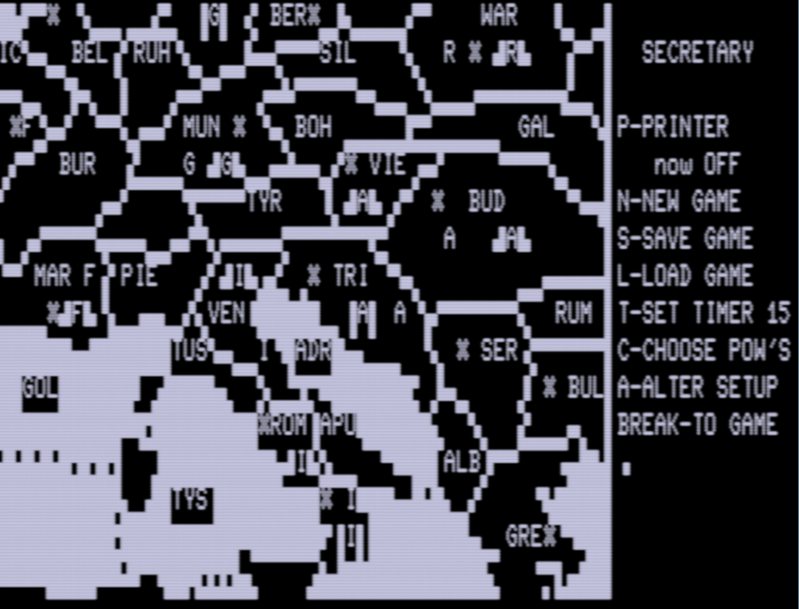
A. Presentation: Adequate, as I said earlier. It is a board game, so there is nothing fancy, but it was pleasant to play.
B. UI, Clarity of rules and outcomes: Good. It could have been even better if the control flags had been easier to distinguish from armies.
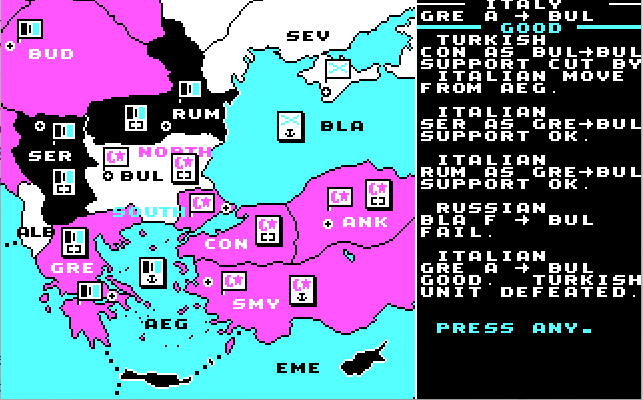
C. Systems: Good. It’s Diplomacy, so the rules are good in themselves, even without any negotiation.
D. Scenario design & balancing: Poor. Boardgames ports are all about the AI, and the AI is lacklustre – I won all my games, including one in Spring 1907 as France, but then I am familiar with the game.
The AI barely attacks, but it defends with pugnacity. It uses an opening library for its first 2 turns and those opening moves are so bad they should let the “generic AI” at the helm: Russia sometimes holds its position with half its armies two turns in a row, Germany ignores the Netherlands and generally speaking the AIs follow their plans even when the human players are doing incredibly aggressive moves – in the test game from the screenshot above I could occupy Vienna and Trieste in the first 2 turns because Austria kept moving South, in another as France I just waltzed into Venice while Italy moved its armies to Apulia and Naples.
The AI sometimes pretends it just formed alliances, non-aggression pacts or similar with other AI players, but in my experience it is just for show and does not influence its behaviour at all.
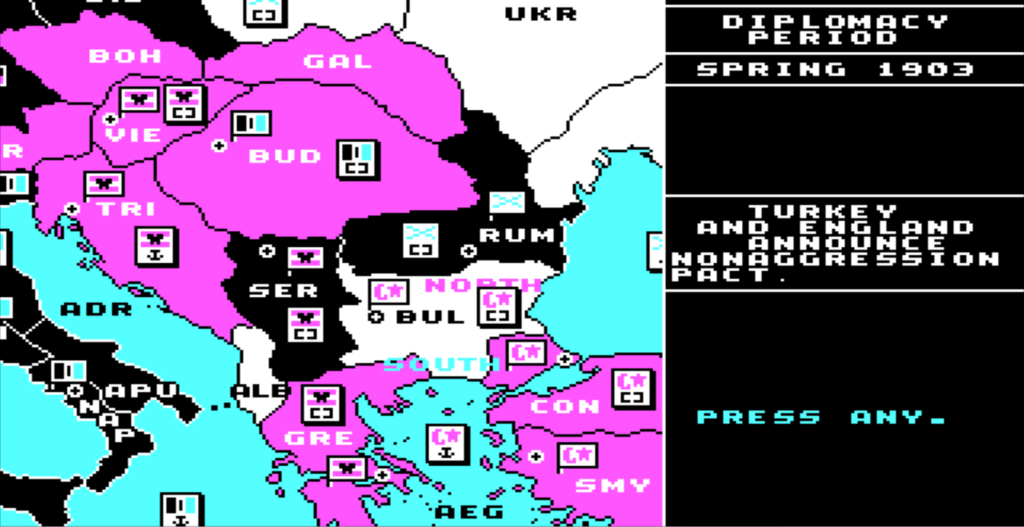
E. Did I make interesting decisions? Well, yes, it is Diplomacy.
F. Final rating: Two stars. A perfect Diplomacy port would be 4-stars, and then this specific port loses 2 stars due to its weak AI.
Reception
We need to split the reactions to Computer Diplomacy into two parts: the ones of the video gamers and the ones of the Diplomacy gamers.
- On the video gamers front, all reviews are highly positive, though they all insist on the fact that the game is multiplayer first. The most representative example is Family Computing, which in November 1984 states that “Diplomacy‘s computerized counterpart is only a shadow of the original […] Computer-controlled countries only execute minor, easy-to-beat military strategies” but gives it the “Best Multiplayer Game of the Year” award in January 1985.
Several reviews even claim that the game is better than the original, for instance Robert Alonso writing for Electronic Games in March 1985 states: “[An] excellent rendition of a classic boardgame, but it is also an improvement“, though it still admits that “Computer Diplomacy does not encourage solitary games against the computer“1985. Similarly, PC MAG in February 1985 calls it “easier and more fun to play than the original.”
All reviews, including some long after the game’s release, insist on the formal quality of the game. For instance, the British magazine ACE reckons as late as February 1988 that the game features “a marvellous scrolling map” and a “friendly control system“, making it “a joy to use“; and just like every other review it disses the computer opponents, explaining “[Computer Diplomacy] can even offer simple fun as a single-player game with six computer opponents, if you want an easy victory!“
- As for Diplomacy players, the reception is mixed. Computer Diplomacy is reviewed initially by none other than Allan B Calhamer, the creator of Diplomacy, in the reference fanzine Diplomacy World #38 [Summer 1984]. This initial review on the TRS-80 version is purely descriptive. Almost nothing happens for the two following years, until someone called Ken Hill writes a lengthy review of Computer Diplomacy in Diplomacy World #46 (Spring 1987). Ken Hill is obviously a weak Diplomacy player (his best performance as Russia against the AI is 37 turns-to-victory), so he has no strong words on the computer’s skill, but most of all he likes Computer Diplomacy‘s “ability to fairly and accurately adjudicate […] After using the program for the last six months to assist with my games, I can t see how I ever managed my games without it!” His conclusion is just a paragraph of lavish praises, ending with: “It is a “must buy” for any serious Diplomacy player or game master and is also an excellent value for the average computer gamer. Avalon Hill should be very proud of this exceptional product“
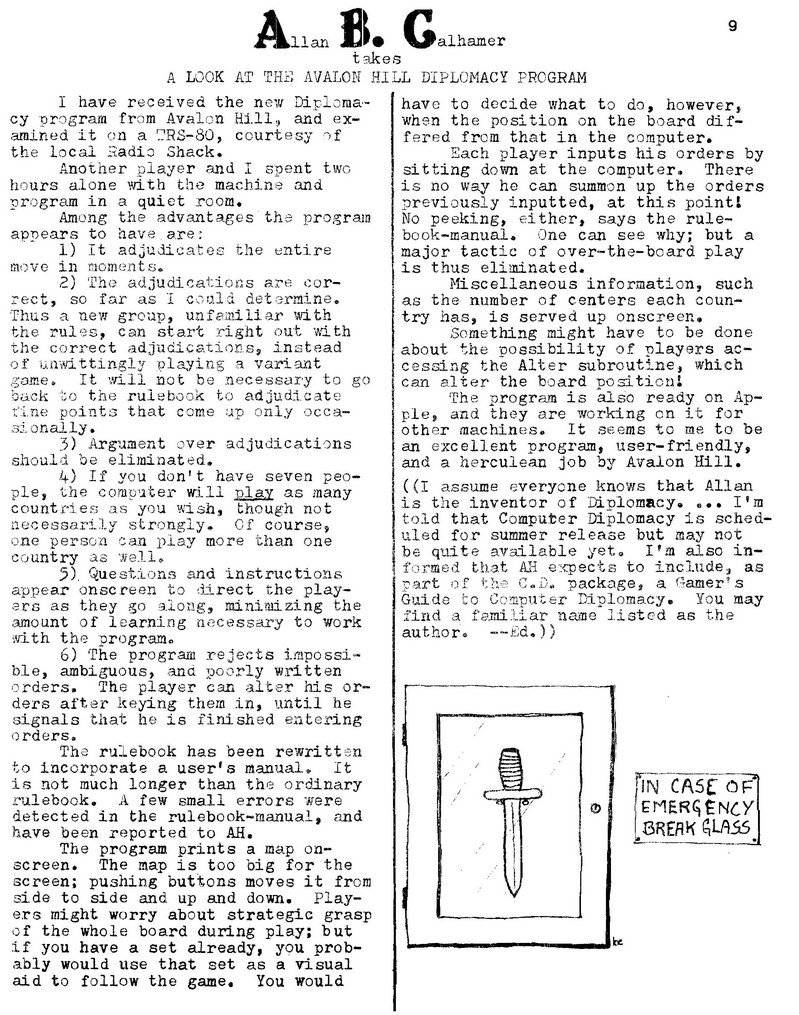
Ken Kill’s article infuriated Frank Cunliffe in Diplomacy World #49 (Winter 1988): “Ken favorably and correctly praises Computer Diplomacy’s graphics and administrative capabilities. Where we disagree is over the program’s ability to play the game.” After this introduction, Cunliffe follows up with a long, very long list of why the AI sucks and why Hill probably sucks, too. He then reports on a test game he launched with 7 computer players which had not ended after he ran it until Year 2002 – though I believe he is not totally honest because from his report the game had stalemated around Year 1985. Amusingly, the same issue also included a shorter review by a “novice” player, praising the game: “I have found that the computer Diplomacy game is fun to play, but also It is very forgiving, and for a beginner that’s not so bad an idea“
In any case, the game must have gained in popularity, because in the 1989 DIPCON a new “Computer Diplomacy division” was added, with the following explanation in Diplomacy World: “Even though the current computer Diplomacy game contains substantial defects, the growing popularity of computerized Diplomacy deserves recognition by the entire hobby, and the increased use of computers within the hobby demands our attention.”
Owing to the weakness of the AI, the “competition” was about beating it as fast as possible – in time, not in turns! Only 9 competitors tested their skills in this “glorified typing contest“, as it was immediately lambasted. It was poorly received and there was no Computer Diplomacy division in 1990.
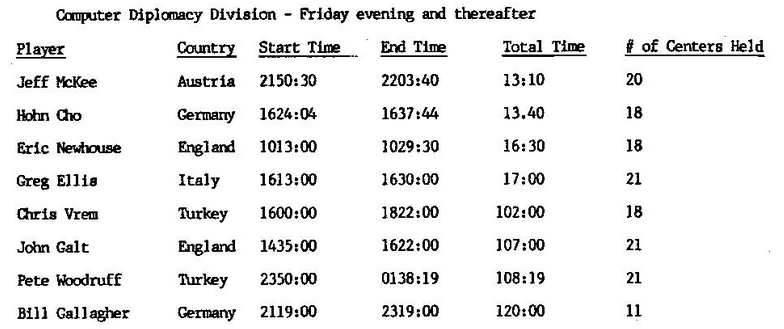
As far as I could gather, that’s the end of the history of today’s Computer Diplomacy. In 1990, a company called Virgin Mastertronic released another Computer Diplomacy on C64, but this time with a real diplomatic layer and apparently a better AI – despite the name it is a totally different port. This version would become the new reference Diplomacy on computer, if such a thing exists and if I ever reach 1990 you can be sure I will cover it as well!
As a side note, rating Diplomacy forces me to also rate Fortress, which I had not rated under the ludicrous claim that I don’t rate boardgames. Fortress ends at the 28th position, so slightly below Diplomacy.